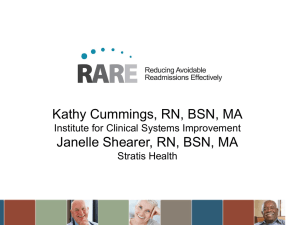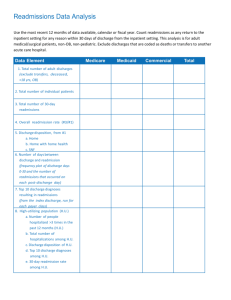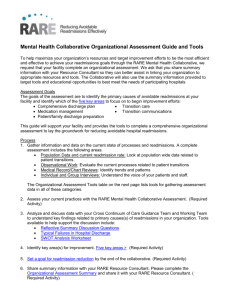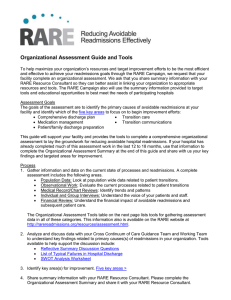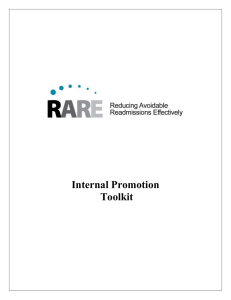Getting Started and Organizational Assessment
advertisement
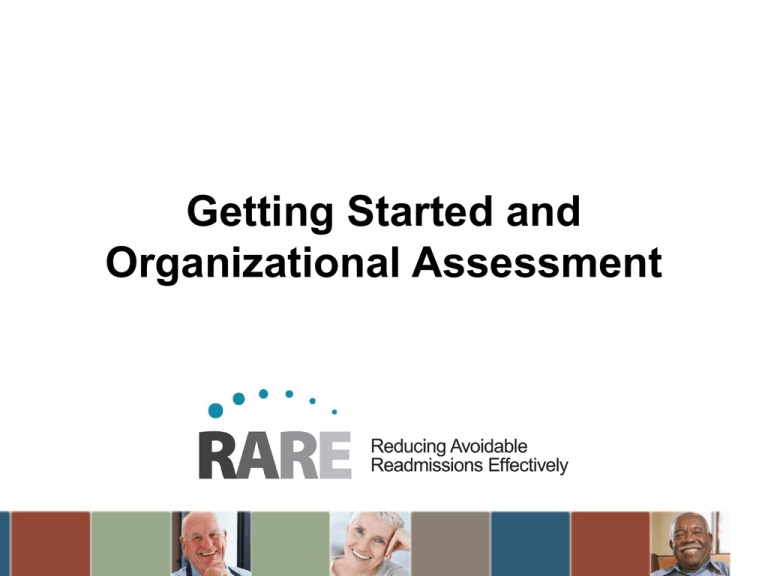
Getting Started and Organizational Assessment RARE Campaign Summary • Campaign across the continuum of care to reduce avoidable hospital readmissions across Minnesota and surrounding areas • Regional approach, supported by hospitals, providers, health plans, other key stakeholders – More than 60 participating hospitals to date • Goals: – Prevent 4,000 avoidable readmissions in 18 months – Reduce the overall readmission rate by 20%—from 5.8% in 2009 to 4.6% by Dec. 31, 2012 Getting Started 1. CEO selects an executive sponsor 2. CEO selects working team leader 3. CEO and executive sponsor communicate reasons for engaging in the RARE Campaign, PPR data and specific readmission reduction goals 4. CEO communicates with community stakeholders regarding the RARE Campaign and engages them in the work 5. CEO selects physician champion 6. Cross Continuum of Care Guidance Team formed 7. Working Team formed 8. Organizational assessment completed 9. RARE focus area selected for improvement work 10.Organizational resources to accomplish improvements provided RARE Hospital Requirements – Commit to specific readmission reduction goals set based on MHA analysis – Conduct an organizational assessment of readmissions; tools provided by RARE Operating Partners – Share organizational assessment results and readmissions data with the RARE Operating Partners – Commit to improving performance in key areas identified through the organizational assessment – Agree to publicly disclose participation in campaign Purpose of the Organizational Assessment Organizational Assessment Steps 1. Create a plan to gather information and data on your organization's current state of processes and readmissions. 2. Analyze and discuss data with working team and guidance team to understand key findings related to primary causes(s) of readmissions in your organization. 3. Identify key area(s) for improvement. 4. Share summary information with your RARE resource consultant. Gather Information and Data Overview • A complete assessment includes: – Population Data: Data related to patient transitions – Observational Work: Evaluate the current processes related to patient transitions – Medical Record/Chart Reviews: Identify trends and patterns – Individual and Group Interviews: Understand the voice of your patients and staff – Financial Review: Understand the financial impact of avoidable readmissions and subsequent patient care • Tools: www.rarereadmissions.org/resources/assessment.html Gather Information and Data Observation • Evaluate the current processes related to patient transitions, asking questions such as: – – – – When are discharge summaries available to the next caregiver? How does that information get shared with the next caregiver? What is your process for medication reconciliation? How is it done? When is it done? • Tools: – – – – – – 5 Whys Admission Assessment Observation Cause and Effect Diagram (Fishbone) Discharge Observation Patient Teaching Observation Process Mapping/Value Stream Mapping Gather Information and Data Interviews • Understand the voice of your patients and staff – Individual interviews can help identify patterns, trends, and opportunities for improvement from the staff member and patient perspective. – Group discussion and interviews allow for reflection and brainstorming of challenges and opportunities. • Tools: – Interviews with Patients, Family Members, and Care Team Members: questions for each audience – Readmission Worksheet: combines interviews with chart review for a fuller picture of individual readmissions Discuss with Team - Tools • Reflective summary discussion questions: – What themes emerged? – What, if anything, surprised you? – What new questions do you have? What are you curious about? Is there a way we can answer these questions? – What assumptions about readmissions that you held previously are now challenged? – What opportunities for improvement will add the most value to your organization (value = (quality + safety)/cost)? Discuss with Team - Tools Typical Failures in Discharge Planning: Medication Management • Medication reconciliation does not align with medications patient is taking when patient arrives home • New medications not available on discharge, patient may have difficulty filling in timely manner Transition Care • No follow-up appointment, or follow-up needed with additional provider expertise • Inability to keep follow-up appointments because of illness or transportation issues Patient and Family Engagement in Discharge Preparation • Patient/family failure to ask clarifying questions on instructions and plan of care • The care provided by the facility unravels as the patient leaves the hospital Comprehensive Discharge Plan • No advance directive or planning beyond do not resuscitate status • Patient returns home without essential equipment Transition Communication • Poor communication of the care plan to the nursing home team, home health care team, primary care physician, or family caregiver • Current and baseline functional status of patient not described, making it difficult to assess progress and prognosis for post-acute care providers Strengths, Weaknesses, Opportunities, Threats WEAKNESSES Attributes that hinder the vision. EXTERNAL INTERNAL STRENGTHS Attributes that help achieve the vision. OPPORTUNITIES THREATS External conditions that help achieve the vision. External conditions that damage the vision. Identify Key Area(s) for Improvement • • • • • Comprehensive Discharge Planning Medication Management Patient and Family Engagement Transition Care Support Transition Communication Organizational Assessment Summary • Includes: – – – – Activities completed Key findings Describe areas identified for improvement Prioritize improvement opportunities • Share summary with RARE resource consultant • Complete within 4 – 6 weeks of committing to campaign Next Steps • Create an action plan for your priority area(s) – Include multiple PDSA cycles – Start small—but start! • Tools and models available for each key area on website starting late Sept. • Action Day: Oct. 18—details coming soon! • Webinars and other events at www.rarereadmissions.org/resources/calendar.html • Utilize your RARE resource consultant Thank You For Helping Everyone Sleep More Peacefully. Questions? www.RAREreadmissions.org Thank you! Kathy Cummings: kathy.cummings@icsi.org Karla Weng: kweng@stratishealth.org
